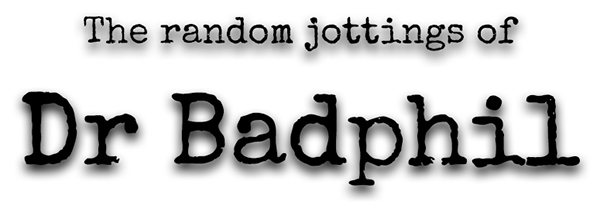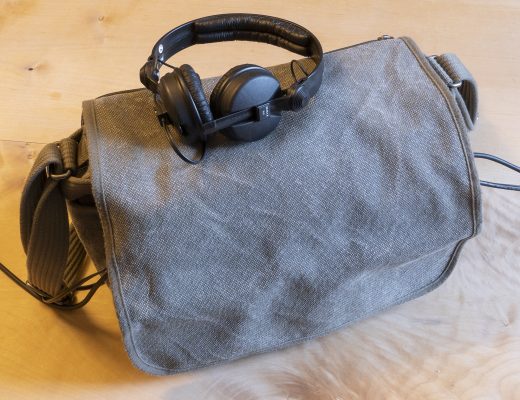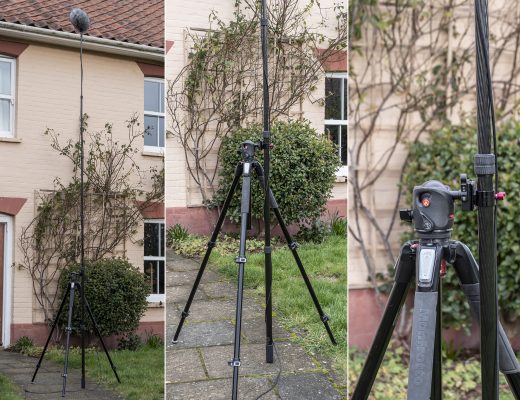
My series of field tests of the new Sennheiser MKH 8030 fig 8 (which kicked off with initial tests, moved on to mid-side recording, encompassed field recording, included comparison with the MKH 30, and most recently included use in a native B-format array) have led to various questions being asked of me, both via this blog and on sound forums. An interesting one was whether the mic needed the modular filter that Sennheiser make for the MKH 8000 series: the MZF 8000 ii. This filter was announced at the same time as the MKH 8030, in September 2023, but, as I understand it, was available beforehand as a special order option instead of the original MZF 8000. Both filter modules are the same in terms of the switchable -10 dB pad and the fixed low-cut filter of –3 dB @ 16 Hz (18 dB/oct), but differ with regard to the switchable low-cut filter: on the newer filter the latter is –3 dB @ 70 Hz (18 dB/oct), compared to the original’s –3 dB @ 160 Hz (which was much less steep too: I can find no authoritative specs). This stems from understandable user feedback, since a lower and steeper HPF around the 70 Hz frequency of the new filter is of more use to broadcast and filmmaking sound for those mics in the MKH 8000 series that don’t have in-built bass roll-off (i.e. all except the MKH 8060 and MKH 8070 shotgun mics): more use, that is, for reducing low-frequency wind noise and handling noise.
While some might (and, indeed, do) lament the absence of a built-in pad and switchable low-cut filter in the MKH 8000 mics, as found in the earlier MKH mics, the modular nature of the MZF 8000 ii filter means it is more flexible and, also, the end result is quite different. Flexibility is seen in the fact that the MKH 8000 mics, sans filter, can be kept small and, moreover, when the filter is used, this can be placed either between the head and the XLR module (making for a 29mm longer mic) or, if using an MZL cable, well away from the mic head, and next to the (then remote) XLR module. As for sonic differences between the MZF 8000 ii and the in-built equivalents of the MKH 30, 40 and 50, arguably the fixed 16 Hz low-cut filter of the former simply compensates for the increased bottom end of the MKH 8000 series mics, but there remains quite a difference in the switchable low-cut filters: the MKH 30, 40 and 50 have much higher and gentler low-cut filters, designed to address proximity effect, rather than the lower and steeper filtering of the MZF 8000 ii filter that is geared to reducing wind and handling noise. And, to add complexity, the MKH 20 switchable filtering is only concerned with high frequencies, being to modify the mic between near and diffuse field applications (with, of course, the proximity effect not applying to an omni anyway). The earlier MZF 8000 filter, therefore, was more comparable to the switchable elements of the MKH 30, 40 and 50, while the newer MZF 8000 ii is more overtly geared to production sound.

OK, so much for the theory: how does the MZF 8000 ii perform? With the focus of the MZF 8000 ii on production sound, I fitted the filter to one MKH 8030 and mounted a pair of the mics in Rycote Invision 7 shockmounts to a short stereo bar on the end of a carbon-fibre boom pole. First off I compared the impact of mild shake (from straining muscles) on the two mics, with no high-pass filter (HPF) on the recorder, and just the fixed 16 Hz low-cut filter on the one with the MZF 8000 ii module fitted.


As expected, the MZF 8000 ii filter removes a significant amount of the infrasound, whilst having little impact on other low-frequency performance.
Moving on now to compare the effects of using the high-pass filters built-in to most recorders and mixers versus, or in conjunction with, that of the MZF 8000 ii filter, first of all I repeated the boom pole test with one mic with the recorder’s 40 Hz HPF (40 Hz being the lowest setting on Sound Devices 788T) with the other mic using the MZF 8000 ii’s 16Hz filter and the 788T’s 40 Hz HPF:


Again, as expected, the 16 Hz low-cut filter of the MZF 8000 ii adds significantly to reduction in handling noise from the boom pole by use of the recorder’s 40 Hz HPF.
For most such boom pole (or, indeed, pistol grip) mounting of a mic of course one would anticipate using a higher frequency HPF such as the switchable one built into the MZF 8000 ii, so that formed the next test: i.e. comparing the Sennheiser module with the 70 Hz HPF of the Sound Devices 788T.


Going by the frequency of the two HPFs some might expect that the results would be same, but the MZF 8000 ii’s 70 Hz filter has a much steeper slope (18 dB/oct) compared to that of the 788T (selectable at 6 dB/oct or 12 dB/oct: I used the latter), and this difference is clear. By contrast, the more recent Sound Devices 8-series and Mix-Pre recorders have 18 dB/oct HPFs, so the final test with the boom pole compared the MZF 8000 ii’s 70 Hz HPF to that of a MixPre-3: the latter only goes up in 20 Hz steps, so was set at 80 Hz.


Given the steepness of the slope and the slightly higher frequency, the MixPre-3 shows more attenuation of boom pole handling noise.
So far, this is all very much as expected from the specifications: but where does this leave us? What are the benefits of the MZF 8000 ii in terms of its HPF if the recorder/mixer has one too? And, likewise, what is the benefit of the -10dB pad if, as is sometimes the case (e.g. the 788T), the recorder can supply 48v phantom power in line-input mode to cope with mics recording very high SPLs and consequently producing high outputs? Well, this is complex, and will reflect the type of material being recorded, the modus operandi of the sound recordist, and the capability of the mixer/recorder. In some cases, stacking HPFs (i.e. in both the mic and the recorder/mixer) may be useful to give a steeper slope: this is especially relevant if the recorder itself doesn’t offer anything as steep as 18 dB/oct. In many uses the fixed 16 Hz HPF of the MZF 8000 ii will be useful to remove unwanted infrasound, and many mixer/recorders do not have HPF options that go this low. In some cases the MZF 8000 ii will stop the mixer/recorder preamps being overwhelmed by, or giving too much headroom to, unwanted low frequencies: this is especially relevant with those recorders (such as the Zoom F8n) where the HPF comes after the trim/gain and ADC. Of course, any such uses need to be balanced against the additional weight of the module (relevant at the end of a long boom pole) and the lack of accessibility of switches if the mic is in a windshield. And it also needs to be considered against other options that are outside the mic or the recorder/mixer, such as the switchable 80 Hz HPF built into the XLR mount of the Rycote Nano Shield (and therefore accessible outside a windshield).
So, in short, it will come down to personal choices: the module is primarily of use to those for whom mic handling noise, wind noise, unwanted low-frequency ambient noise, and, for the pad, extreme SPLs are issues, which will mainly comprise production/ENG sound, sound effects recording, and, to a lesser extent, field recording. As for using the MZF 8000 ii with the MKH 8030? Well, although this has a decent bottom end for a fig 8 mic, it naturally has less in the way of a low-frequency response than its omni, wide cardioid, cardioid and supercardioid siblings and is also less likely to be swung around vigorously on a boom than, say, the supercardioid MKH 8050. In short, to date I haven’t found a need to use the MZF 8000 ii with the fig 8 MKH 8030: others may draw different conclusions. However, I’ve found it useful to have the MZF 8000 ii in the kit, and so far have used it most with just the 16 Hz low-cut filter with the MKH 8020, where the very bottom of the extended low end of this omni mic isn’t always wanted: and its good to be able to have the 70 Hz (18 dB/oct) filter and the -10dB pad there for whenever the need arises. Turning this around the other way, and again unlike some others, I’m glad that with the MKH 8000 series mics Sennheiser took a modular view to the HPF and pad capabilities since, for the bulk of my recording activities (and I suspect those of so many others), they aren’t needed and the consequently more compact form is useful: evidently the MZL cables take that compactness further, but that’s another matter!





14 Comments
This is interesting and not just of interest to insomniacs as you jest in the field recording FB page! I’m just looking at building a DMS system with an 8030 and 2 8040s or 8050s, and notice that the Pianissimo cannot accommodate the MZF filter in a DMS arrangement. Philippe seems pretty insistent that the MZF is needed with the 8030 because of handling noise, or recommends filtering in post or at the recorder (iirc).
It seems that for those of us dreaming of cramming a DMS setup into the smallest package (and thus risking more wind and perhaps handling noise), using HPFs at the recorder seem like a good idea. Or in post.
Which raises the age old debate, which I’ve never remembered the results of, of whether or not it’s bad to rely on filtering in post and better to use the low-cut filters on the mics.
Thanks Charles. What degree of HPF is needed will to a significant degree depend on what handling it will get: even if on a boom pole or pistol grip, movement (and therefore handling) of a DMS rig is usually pretty modest. In terms of HPFs in the mics, in many case we don’t know where they sit in the circuit, but with the MZF 8000 ii at least its modular form tells us that it is after the mic’s own preamp, so an HPF in the mixer/recorder (at least if before the trim/gain and ADC) should be as effective assuming it can be as steep and of the same frequency. An HPF in post evidently runs the risk of headroom being given over in recording to low frequencies that are then removed: whether that matters will largely depend on how much unwanted low-frequency sound is recorded (e.g. a lot of wind and handling noise). Not sure this helps much! Cheers, Roland.
Thanks, Roland, for the reply. I don’t quite understand why “headroom” would be “given over” to low frequencies. I just don’t understand mics that well. But is it a question of the ADC in the recorder? Isn’t that where headroom comes into play, at the recorder? I would think that 32 bit recording would render that mostly moot, no? Perhaps an explanation would take too long…
I wonder if the mixpre’s HPF is applied after trim/gain…
(These posts are remarkably useful and informative! You really should add one of those “buy me a beer” buttons if you aren’t getting paid somehow to do this.)
Like I said, I don’t know mics/etc. well enough.
Hi Charles,
By ‘giving too much headroom to unwanted low frequencies’ I meant that if you have a lot of such unwanted low-frequency sound, or infrasound, arising from buffeting wind or handling noise etc., that to prevent clipping of the signal, you would have to reduce gain considerably: in effect, you could see a substantial drop in the trim/gain applied to the signal you are interested in recording, with a consequent lowering of the signal-to-noise ratio. With 32-bit recording this should be less of a problem as you say, but I think it would be interesting to test this in practice (I think people often assume that the analogue parts of the chain have been removed!): I don’t use a 32-bit recorder as, for my recordings, it is a solution to a problem that doesn’t exist!
In terms of the MixPre-series recorder HPF location, Sound Devices block diagrams show this located prior to the trim/gain.
And thanks so much for the kind words: glad the posts are useful. You are the second person who has suggested a ‘buy me a beer’ button this week, and it isn’t something I have ever thought about: perhaps I should?!
Cheers,
Roland
Thanks so much for these post, i have been waiting for the mkh8030, and would love to have a ms cosi setup for it.
And still having to decide either a 8050 vs 8040 intending to use on a boom for docu.
Thanks Martijn,
Not an easy call: the 8050, of course, would have more use on its own on a boom (esp. indoors) for dialogue/interviews.
Cheers,
Roland
Think i will start with no filter and use the 70hz filter of 833 (as i learned that this is 18db/oct) and if i remember correctly 3rd order ?
Sounds sensible Martijn, not least as the 833’s HPF goes down to 10Hz. An 18dB/oct HPF is 3rd order by definition. Not quite sure with the 833 how it works with the HPF’s 1st stage only being before the gain/trim (preamp) and the 2nd stage being post-ADC: does that mean a 6dB/oct or 12db/oct analogue HPF? But that is just idle curiosity!
[…] been nothing but responsive, charming and helpful otherwise, not least including loan of a pair of Sennheiser MZF 8000 ii filters (which Cinela recommend for use in these models) and a Kelly rain cover in the package and letting […]
What a fantastic blog. You’ve been an invaluable resource to me for MKH 8000 answers. Question: when used with Sennheiser’s MZL cables, can the MZF 8000 II be in line either on the mic end or the XLR end, or is it restricted to one position?
Thanks James. The MZF 8000ii can be used equally well at either end of an MZL cable, which is good since you can keep the small size of the mic.
Cheers,
Roland
Hello there! I’m looking at a MidSide rig, mkh 8030 & 8040, expecting windy outdoor conditions for recording wildlife, birds in particular. Would I need the MZF 8000 ii for both mics? Also what would your preferred windjammer be~Rycote, Cinela or Radius? With thanks…and I’d def be hitting that Buy Me a Beer button!
Hi Alan,
Whether or not you need an MZF 8000ii will depend on the conditions, the position of the windshield, the nature of the windshield, and what options your recorder/mixer has for HPF: sorry to be vague, but it’s really something you judge on location. If thinking about whether you need to buy a pair, I’d try without first and see whether you really have an issue. As for the windshield, for best transparency and wind protection of those three makes, I would go for a Cinela Pianissimo, but there are pros and cons for that, the Rycote Cyclone and the Radius Mini-ALTO. Ditto my larger Mega-Blimp: you wouldn’t want that on a boom pole!
Cheers,
Roland
[…] in high-pass and pad switches of the MKH 8018, so if you want to add these, you will need to add an MZF 8000 ii filter module, which adds another 29mm in length and 26g in weight. Of course, the impact of this can be […]